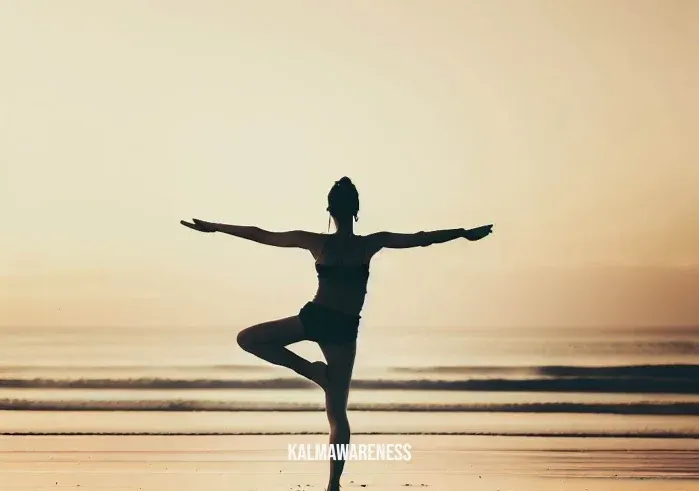Yoga Flamingo Pose: Find Balance and Grace
Yoga is not just about physical exercise; it’s a journey of self-discovery and mindfulness. In this article, we delve into the captivating world of the Yoga Flamingo Pose, a unique posture that embodies balance, strength, and tranquility. Let’s explore this pose together, understand its origins, benefits, and how to master it.
Table of Contents
- Introduction
- Pose Description
- Origins and Meaning
- Benefits of the Yoga Flamingo Pose
- How to Perform the Pose
- Next Part: Embrace the Beauty of Yoga
Introduction
Yoga is a harmonious blend of physical postures, breathing techniques, and meditation that nourishes both the body and mind. The Yoga Flamingo Pose, often referred to simply as the Flamingo Pose, is a graceful and enchanting asana that challenges your balance and flexibility. It is more than just a pose; it’s an exploration of your body’s capabilities and an invitation to embrace serenity.
Pose Description
- Pose Name: Yoga Flamingo Pose
- Original Name: Phoenicopteris Asana
- Difficulty Level: Intermediate
- Pose Category: Standing Balance Pose
- Exercise Duration: 30 seconds to 1 minute (beginners), 1 to 2 minutes (advanced)
Origins and Meaning
The Yoga Flamingo Pose draws inspiration from the elegant stance of a flamingo, a bird known for its poise and grace. Just as a flamingo stands on one leg, this pose challenges you to find stability on a single leg while engaging your core and maintaining a sense of tranquility. The pose symbolizes finding balance amidst life’s challenges, both physical and metaphorical.
Benefits of the Yoga Flamingo Pose
The Flamingo Pose offers a plethora of benefits that contribute to your overall well-being. Some of the key advantages include:
- Improved Balance: This pose hones your balance and coordination skills, enhancing your overall physical stability.
- Strengthened Leg Muscles: The one-legged stance targets and strengthens the muscles in your standing leg, particularly the quadriceps, hamstrings, and calf muscles.
- Enhanced Concentration: Achieving balance in this pose demands focused attention, helping to calm the mind and improve concentration.
- Core Activation: Your core muscles are engaged to maintain the posture, leading to improved core strength and stability.
- Hip Flexibility: The Flamingo Pose involves bending the lifted leg, which opens up your hip and improves flexibility.
How to Perform the Pose
- Starting Position: Begin by standing tall with your feet hip-width apart.
- Shift Your Weight: Shift your weight onto your left leg and lift your right foot off the ground, bending the knee.
- Grip Your Foot: Use your right hand to hold onto your right ankle. Find a focal point to help with balance.
- Engage Your Core: Draw your navel towards your spine to engage your core muscles. This will help stabilize your body.
- Extend Your Leg: Slowly begin to extend your right leg straight behind you, parallel to the ground. Your torso will naturally lean forward as a counterbalance.
- Find Your Balance: Keep your gaze steady and your standing leg slightly bent. Find your balance and maintain the pose for the desired duration.
- Release the Pose: Gently release your right foot and return to the starting position.
Practice this pose mindfully and listen to your body. As you become more comfortable, you can gradually increase the duration of the hold. Remember that balance poses require patience and practice.
@
Embrace the Beauty of Yoga: Unveiling the Benefits of the Yoga Flamingo Pose
In the realm of yoga, each pose is a unique expression of balance, strength, and mindfulness. As we continue our exploration, let’s delve into the myriad benefits of the Yoga Flamingo Pose. This captivating pose not only challenges your physical abilities but also invites a deeper connection with your inner self. So, let’s dive into the enchanting world of the Flamingo Pose and discover its hidden treasures.
Unveiling the Benefits
Strengthens Leg Muscles
The foundation of the Flamingo Pose lies in the strength of your standing leg. As you balance on one leg, your quadriceps, hamstrings, and calf muscles work harmoniously to maintain stability. This consistent engagement not only tones and strengthens these muscles but also contributes to improved lower body endurance.
Enhances Core Stability
The graceful posture of the Flamingo Pose necessitates core engagement to keep your body aligned. Your deep abdominal muscles, obliques, and transverse abdominis activate to support your spine and maintain balance. Over time, this strengthens your core and enhances your overall posture.
Improves Concentration and Mindfulness
Balancing on one leg requires focused attention and a quiet mind. As you concentrate on maintaining the pose, your mind naturally enters a state of mindfulness. This mental clarity and presence can have a calming effect, reducing stress and anxiety.
Increases Hip Flexibility
The extension of your lifted leg behind you helps open up your hip joint and stretches the hip flexors. This can be especially beneficial for individuals with sedentary lifestyles, as it counteracts the tightness that can develop in the hip area.
Develops Neuromuscular Coordination
Balancing poses like the Flamingo Pose stimulate the neuromuscular system, enhancing the communication between your muscles and nervous system. This coordination can translate to improved overall body awareness and control.
Who Should Approach with Caution
While the Yoga Flamingo Pose offers a host of benefits, there are individuals who should approach it with caution:
- Beginners: If you’re new to yoga or have limited experience with balance poses, it’s advisable to practice the pose near a wall or with the support of a chair. This will help you build stability and confidence before attempting the full pose.
- Individuals with Joint Issues: If you have existing ankle, knee, or hip issues, consult a medical professional or a qualified yoga instructor before attempting this pose. Modifications can be made to accommodate your unique needs.
Pose Variations for Different Levels
The beauty of yoga lies in its adaptability. The Flamingo Pose offers variations that cater to practitioners of different experience levels:
- Beginner Variation: For beginners, focus on the standing leg’s stability and balance. You can choose to keep your lifted leg bent at a 90-degree angle for better support.
- Intermediate Variation: As you progress, aim for a straighter lifted leg while maintaining a slight bend in the standing knee. Keep your gaze fixed on a point in front of you to aid in balance.
- Advanced Variation: Advanced practitioners can experiment with a deeper bend in the standing leg, allowing the lifted leg to extend higher. Embrace the challenge of maintaining stability while elevating your leg.
@
Elevate Your Yoga Journey: Unearthing the History and Spiritual Essence of the Flamingo Pose
As we ascend deeper into the realm of yoga, we uncover not only the physical aspects but also the rich history and spiritual dimensions of each pose. In this chapter, we unravel the intricate tapestry that weaves the past and the soulful essence into the Yoga Flamingo Pose. Embark on a journey that transcends the mat and touches the realms of tradition and spirituality.
The Historical Thread
The origins of the Yoga Flamingo Pose can be traced back to ancient yogic texts and teachings. While exact historical documentation may be elusive, the pose’s inspiration draws from the grace and balance exhibited by the flamingo, a majestic bird known for its one-legged stance.
The pose’s integration into modern yoga practices can be attributed to the fusion of traditional asanas with innovative variations. Yoga, as an ancient practice, continues to evolve, adapting to the needs and aspirations of each generation.
Spiritual Significance
The Flamingo Pose, like many yoga postures, embodies more than just physical movement; it carries spiritual symbolism as well. In yogic philosophy, balance and equilibrium are not confined to the body but extend to the mind and spirit. The act of standing on one leg signifies the delicate harmony we seek between opposing forces, be it effort and surrender or strength and softness.
This pose encourages us to find balance amidst life’s challenges, just as a flamingo finds stability in the midst of turbulent waters. As you embrace the pose’s stillness, you’re invited to explore the depths of your consciousness and cultivate a sense of inner tranquility.
Tips for a Deeper Experience
To truly harness the essence of the Yoga Flamingo Pose, consider these tips:
- Mindful Breathing: As you enter the pose, synchronize your breath with your movements. Inhale as you prepare, and exhale as you extend your leg. This mindful breathing enhances your focus and creates a rhythmic flow.
- Gaze and Drishti: Fix your gaze on a steady point in front of you. This focal point, known as a drishti, stabilizes your balance and quiets the mind.
- Engage Your Core: A strong core supports your spine and enhances balance. Engage your core muscles by drawing your navel toward your spine.
Common Mistakes to Avoid
While the Flamingo Pose offers numerous benefits, certain mistakes can hinder your practice:
- Overarching Back: Avoid leaning too far forward, which can cause strain on your lower back. Instead, focus on maintaining a straight spine.
- Locked Standing Knee: Keep a micro-bend in your standing knee to prevent hyperextension and distribute weight evenly.
Modifications for Individual Needs
Every body is unique, and the Flamingo Pose can be adapted to accommodate various needs:
- Injuries: If you have ankle or knee injuries, practice near a wall for support or opt for a bent-knee variation until you’re more confident.
- Limited Flexibility: If hamstring flexibility is a challenge, use a yoga strap looped around your lifted foot. This provides gentle assistance in extending your leg.
Complementary Poses
To further enhance your yoga journey, consider incorporating poses that complement the Flamingo Pose:
- Tree Pose (Vrikshasana): Like the Flamingo Pose, Tree Pose emphasizes balance and grounding. It builds stability in the standing leg and offers a similar sense of rootedness.
- Warrior III (Virabhadrasana III): This pose challenges your balance and strengthens the legs, making it an excellent progression from the Flamingo Pose.



